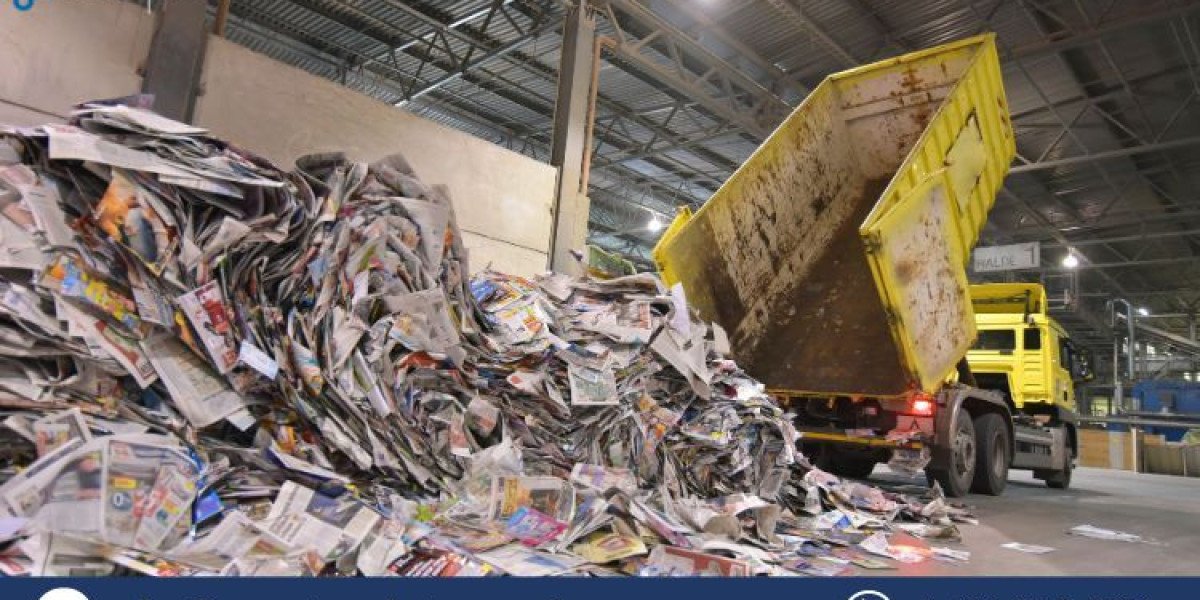The global Recovered Paper Market Size is a vital segment of the recycling industry, facilitating the sustainable use of paper materials and contributing to the circular economy. Recovered paper refers to paper that has been used and then collected for recycling into new paper products. The global recovered paper market, which achieved a significant volume of 277.08 million metric tons (MMT) in 2024, is poised for further growth due to several driving factors. These include the rising demand for tissues, the increase in industrial production, heightened environmental concerns, and the continual advancements in recycling technologies. The market's value is expected to grow at a compound annual growth rate (CAGR) of 2.50%, reaching an estimated 354.69 MMT by 2034.
Key Benefits of Recovered Paper
Recovered paper offers numerous environmental, economic, and industrial benefits, making it a crucial part of modern manufacturing and production processes.
- Environmental Benefits:
- Reduces Waste: Recycling paper prevents millions of tons of paper from being discarded in landfills.
- Conserves Resources: Using recycled paper helps save natural resources, including trees, water, and energy.
- Lower Carbon Footprint: Paper recycling generates fewer carbon emissions compared to manufacturing new paper from raw materials, contributing to climate change mitigation.
Economic Benefits:
- Cost-Effective: Recycled paper often costs less than virgin paper, making it a more affordable option for manufacturers.
- Job Creation: The recovered paper industry creates jobs in collection, sorting, and recycling processes, providing economic opportunities in both developed and developing regions.
Industrial Benefits:
- Supports Circular Economy: By using recovered paper, industries help close the loop in the paper supply chain, reducing dependency on virgin materials.
- Improves Product Quality: Recycled paper can be used in a wide range of applications, such as in tissues, containerboards, and newsprint, without compromising on product quality.
Key Industry Developments
The recovered paper industry is continuously evolving with technological advancements and shifting consumer behaviors. Some of the key industry developments in recent years include:
Technological Advancements in Recycling:
- Innovations in recycling technologies have significantly improved the efficiency of paper recovery. New techniques, such as automated sorting systems and advanced pulping processes, help achieve higher purity levels in recycled paper, making it suitable for a wider range of applications.
Shift Toward Sustainability:
- Growing environmental awareness has led to an increasing demand for sustainable paper products. Brands and manufacturers are prioritizing the use of recycled paper, driven by both consumer preferences for eco-friendly products and stringent government regulations.
Increased Use of Recycled Paper in Containerboard Production:
- The demand for recycled paper in containerboard production has surged, with many paper mills turning to recovered paper to produce corrugated packaging. This has been particularly relevant in the wake of the global shift toward e-commerce, which has intensified the need for packaging materials.
Driving Factors
Several factors are propelling the growth of the recovered paper market, including:
Rising Demand for Tissues:
- Tissue paper products, including toilet paper, napkins, and paper towels, are among the largest consumers of recovered paper. The increasing global population and rising hygiene standards, especially in developing countries, are driving this demand.
Industrial Production Growth:
- The ongoing industrialization, particularly in emerging economies, has led to higher paper consumption. As more industries adopt recycled paper for manufacturing, the demand for recovered paper continues to rise.
Environmental Concerns:
- Governments, businesses, and consumers are increasingly focused on sustainability. Recycling paper helps reduce deforestation and lowers the environmental impact of paper production, aligning with the growing global emphasis on reducing waste and conserving resources.
Innovation and Recycling Efficiency:
- Advancements in recycling technology, such as enhanced de-inking and sorting processes, have made it easier and more cost-effective to recycle paper. This improves the quality of recycled paper, increasing its demand for use in various industries.
COVID-19 Impact
The COVID-19 pandemic disrupted several industries, including the recovered paper market. During the initial stages of the pandemic, there was a slowdown in paper collection and recycling activities due to lockdowns and restrictions. However, as economies reopened and consumer demand for packaging and hygiene products surged, the market began to recover.
- Impact on Recycling Operations:
- Social distancing measures and temporary closures of recycling facilities hindered paper collection efforts. Additionally, the closure of offices and businesses reduced the overall paper waste generated during the early phases of the pandemic.
- Increased Demand for Hygiene Products:
- The increased demand for tissues, paper towels, and toilet paper during the pandemic has supported the market for recovered paper. The growing need for sanitary products led to a rise in paper consumption, boosting demand for recycled paper.
Restraining Factors
Despite its growth prospects, the recovered paper market faces some challenges:
Quality Control Issues:
- One of the key issues in the recovered paper industry is maintaining the quality of recycled paper. Contaminants and foreign materials in the paper can affect the quality of the final product, making it less desirable for manufacturers.
Supply Chain Disruptions:
- The recovery of paper often relies on an efficient supply chain. Supply chain disruptions, such as delays in collection or transportation, can impact the availability of recovered paper.
Competition with Virgin Paper:
- While recycled paper is cost-effective, virgin paper continues to be preferred in some applications, such as high-quality printing and packaging. Additionally, fluctuations in the price of raw materials for virgin paper can make it more competitive.
Market Segmentation
The recovered paper market can be segmented based on various factors, including application, source, and region.
By Application:
- Packaging: Recovered paper is widely used in the production of corrugated packaging materials, which are in high demand due to the rise in e-commerce.
- Tissues: The tissue paper segment is a significant consumer of recycled paper, driven by increased hygiene awareness.
- Printing and Writing Papers: Recycled paper is often used in the production of printing and writing papers, although this application is somewhat limited by the quality of the recovered paper.
- Other Applications: Recovered paper is also used in various other applications, such as in the production of insulation boards and molded pulp products.
By Source:
- Post-Consumer: This includes paper collected after it has been used by consumers, such as newspapers, magazines, and cardboard.
- Post-Industrial: This type of paper comes from industrial processes, such as leftover packaging material and paper waste generated by manufacturers.
By Region:
- North America: The North American market is one of the largest for recovered paper, with significant demand from the United States and Canada.
- Europe: Europe is another major market, driven by strong recycling programs and a high level of environmental awareness.
- Asia-Pacific: Asia-Pacific, especially China and India, is a rapidly growing market, driven by industrialization and the rise in e-commerce.
- Rest of the World: Markets in regions such as the Middle East, Latin America, and Africa are also expected to see growth as recycling programs expand.
Market Outlook
The global recovered paper market is set to grow steadily over the forecast period of 2025-2034, with a projected CAGR of 2.50%. This growth will be driven by the continued emphasis on sustainability, increasing demand for tissue products, and the rise of recycled paper in packaging. The recovery of the paper recycling industry from the disruptions caused by the COVID-19 pandemic, coupled with innovations in recycling technologies, will further fuel the market's expansion.
Major Key Players
Several key players dominate the recovered paper market, driving growth through innovation and investments in recycling technologies. These include:
- Waste Management, Inc.
- Smurfit Kappa Group
- DS Smith Plc
- Republic Services, Inc.
- Cascades Inc.
- SUEZ
- Others
Opportunities
The recovered paper market presents several opportunities:
Innovation in Recycling Processes:
- Companies investing in advanced technologies to improve recycling efficiency will benefit from higher-quality recycled paper, leading to greater demand.
Expansion in Emerging Markets:
- Growth in emerging economies, especially in Asia-Pacific and Latin America, offers significant opportunities for recovered paper producers, as recycling systems and paper consumption expand.
Government Initiatives:
- Governments worldwide are pushing for more sustainable practices, creating opportunities for businesses in the recycled paper sector.
Challenges
The key challenges facing the recovered paper market include:
- Fluctuating Paper Prices: Price volatility in both virgin and recycled paper can impact profitability.
- Contamination Issues: Maintaining the purity of recycled paper and ensuring that it meets quality standards is an ongoing challenge.
- Logistical and Supply Chain Constraints: Efficient collection, sorting, and transportation of paper remains a critical issue, especially in remote regions.
Scope
The recovered paper market is expected to expand at a steady pace, with growth supported by technological advancements, increased demand for sustainable products, and supportive regulatory frameworks. As recycling efforts intensify globally, the market will continue to be a key driver of the circular economy.









